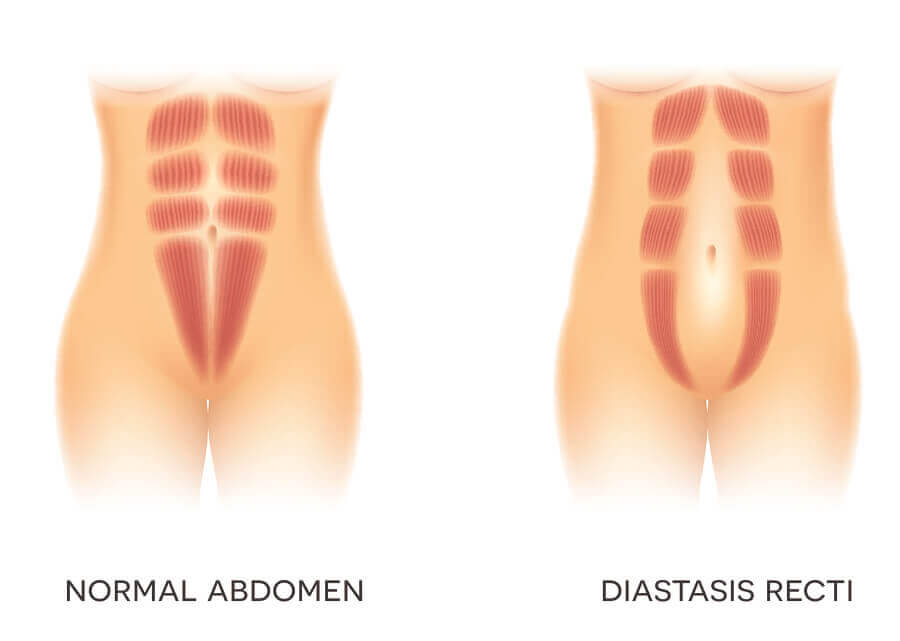Diastasis Recti: What Is It and What Causes It?

Have you recently given birth or had abdominal surgery? If so and you’ve noticed a separation or a bulge in your tummy, you might have diastasis recti.
But there’s really no need to worry because you can recover from it. Let’s take a closer look.
What is diastasis recti?
Diastasis recti occurs when the two rectus muscles of the abdomen separate from each other. These are the muscles on the outside of the abdominal wall. (In other words, your six-pack).
Under normal conditions, these muscles are joined by a central line, the linea alba. This line runs from the chest to the pubis.
However, after certain traumatic conditions, the linea alba can deteriorate, weaken and stop working. This causes the muscles to separate.

In the worst cases, you can see diastasis recti with the naked eye. It looks like a bulge or a kind of sinking in the center of the abdomen. It’s a problem that must be sorted out and not just for aesthetic reasons. Because it could be a symptom of another more major problem.
The rectus abdominis muscle forms part of the abdominal wall. This muscle helps regulate intraabdominal pressure and also compresses the thoracic viscera. If these two processes aren’t happening, you might suffer lower back pain or pelvic floor dysfunction.
Also, read What Is Abdominal Strain?
What causes it?
The two main causes are pregnancy and abdominal surgery. Natural abdominal stretching during pregnancy is normal. Indeed, every pregnant woman will have some level of diastasis recti in the third trimester of their pregnancy. In fact, it’s a necessary process that allows the baby to keep growing.
However, for many women, the gap remains widened at eight weeks after birth. Furthermore, if it’s left untreated it could remain for up to a year.
Two out of three women with this disorder will also have some level of pelvic floor dysfunction. These problems will continue and increase over the years if left untreated.
However, this isn’t just a problem for women, Indeed, men can also suffer diastasis recti. This might be due to abdominal surgery, bad weightlifting techniques, or increased body weight.
How do you know if you have diastasis recti?
The best way to confirm a diagnosis of this disorder is to see your doctor. However, you can take some steps to help you find out if you have this particular problem.

How to recognize the symptoms
- First, lie on the bed and fix your eyes on your abdomen.
- Do you notice a lump in the middle of your tummy?
- Then put your fingers under your belly button and follow a line to your pubis.
- Do your fingers sink or is your abdominal tissue firm?
- In the same position, try coughing.
- Does your abdomen stay flat or can you see something protruding?
If you notice a lump during the test, or your fingers sink, or when you cough your abdomen protrudes, you might have diastasis recti. This means there’s an imbalance in your intra-abdominal pressure.
Also, read The Optimal Size of the Abdominal Circumference
How it’s treated
Whilst you can’t always prevent this condition, it can be treated to stop further damage from occurring. Diastasis recti is treated with an integrated program designed to align, connect and strengthen the entire core of your body.
During treatment, you need to take several things into account such as breathing, posture, body control, and pelvic floor work.
High impact exercises like aerobics and running or traditional abdominal exercises where you flex your muscles are not recommended. This is because they increase abdominal pressure and put further pressure on your pelvic floor muscles.

It’s generally recommended that you see a health professional so they can work out what treatment you need. After this medical consultation, you’ll then be able to start your personalized treatment plan.
Your therapist will use a variety of exercises from different disciplines. These might be hypopressive, breathing, and pelvic floor exercises.
The idea is that you’ll regain your figure and avoid any complications associated with diastasis recti. The exercises will also help you improve your body awareness, and you’ll be able to establish good habits concerning your posture and the way you move.
All cited sources were thoroughly reviewed by our team to ensure their quality, reliability, currency, and validity. The bibliography of this article was considered reliable and of academic or scientific accuracy.
- Sperstad JB, Tennfjord MK, Hilde G, Ellström-Engh M, Bø K. Diastasis recti abdominis during pregnancy and 12 months after childbirth: prevalence, risk factors and report of lumbopelvic pain. Br J Sports Med. 2016;50(17):1092–1096. doi:10.1136/bjsports-2016-096065
- Thabet AA, Alshehri MA. Efficacy of deep core stability exercise program in postpartum women with diastasis recti abdominis: a randomised controlled trial. J Musculoskelet Neuronal Interact. 2019;19(1):62–68.
- Akram, J., & Matzen, S. H. (2014). Rectus abdominis diastasis. Journal of Plastic Surgery and Hand Surgery. Informa Healthcare. https://doi.org/10.3109/2000656X.2013.859145
- Brauman, D. (2008). Diastasis recti: Clinical anatomy. Plastic and Reconstructive Surgery, 122(5), 1564–1569. https://doi.org/10.1097/PRS.0b013e3181882493
- Michalska, A., Rokita, W., Wolder, D., Pogorzelska, J., & Kaczmarczyk, K. (2018). Diastasis recti abdominis – A review of treatment methods. Ginekologia Polska. Via Medica. https://doi.org/10.5603/GP.a2018.0016
- Nahabedian MY. Management Strategies for Diastasis Recti. Semin Plast Surg. 2018;32(3):147–154. doi:10.1055/s-0038-1661380
This text is provided for informational purposes only and does not replace consultation with a professional. If in doubt, consult your specialist.








